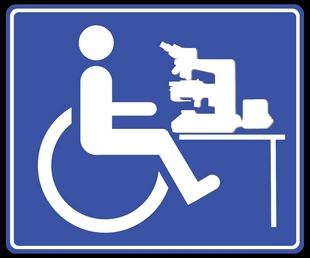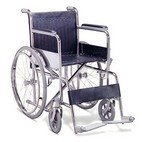Anyone who has stumbled upon my blog may know of the troubles I encountered with my second powerchair--a
Permobil. Problems with that powerchair began almost immediately after taking posession of it, and continued to where virtually all parts of the chair had been replaced, at least once--well before I was eligible for government support in purchasing a replacement.
Since that time I've heard from numerous owners of a
Permobil with similar issues and frustrations. My personal advice is to stay away from this flawed brand!
My first chair was a
Quantum, which ran well for
seven years, with only one motor (under warranty) and the joy-stick needing replacement in that time period (not including normal wear on the tires.) It was repossessed by the ADP government agency on my receipt of the
Permobil (something to do with the tilt-seat which I really didn't need in the first place).
The
Permobil was a nice looking chair and I was assured by the vendor that it was reliable. I regretted the choice early on. The curly-cue sides rails do not permit hanging side pockets for personal items such as keys, etc. The only plus-side to the design of the
Permobil I found was that the motors can be disengaged at the front, by the user, rather than at the rear. This may be useful if you have some use of your limbs, as I have, to maneuver yourself to a more advantageous location during a breakdown.
A sympathetic friend found a used
Quantum 300 powerchair which he offered for my permanent use. This workhorse freed me from the
Permobil nightmare and it continues to work to this day (I did replace both motors after one failed).
On July 12, 2018: having met eligibility for a replacement powerchair, I contacted an Assisted Device Program (ADP) representative at a major local hospital, requesting assessment for a new wheelchair. I received by e-mail a
Microsoft Excel form to fill out with my pertinent information, which then was returned. This I did and then waited.
August 10, 2018: Not knowing how long these things may take, I waited patiently. Not having received an update on my submitted request after a month, I again contacted the ADP representative. She claimed not to have received my e-mailed
Excel document. I suppose I should have asked for a receipt on submission. I found the original document in my "sent" folder and re-sent the same form which they now received. (my e-mailed document did not "bounce back". They must have lost it,)
September 18, 2018: I met with this ADP representative in my home where she assessed my needs and took measurements of my freebie
Quantum. She filed my request with the government agency and we waited for approval.
Late March, 2019: Almost a half-year after my request was filed, I was approved for a new powerchair
April 2, 2019: The initial chair recommended by the ADP agent would simply not meet my requirements. The vendor who delivered the demonstrator model quickly assessed my situation and proposed another
Quantum model.
May 19, 2019: The vendor I had selected delivered a
Quantum Q6 model which I found much more to liking and suitable to my needs. The vendor placed an order with the manufacturer to construct a Q6 to my specifications.
June 11, 2019: The invoice for my
Quantum Q6 bears this date and has a listing of the components specifically requested, including seating.
August 22, 2019: I took possession of the new
Quantum Q6.
I found this
Quantum model an improvement over my old freebie
Quantum, particularly the suspension. I find it climbs over obstacles much more smoothly. The demonstrator came with similar curly-cue side-arms. My model has the more common square frame side supports which
Pride (Quantum) supplied with small side bags on each side.
I am keeping my freebie Quantum as I never want to be without motorized wheels again. Those who have read this blog know I spent the
summer of 2017 powerless as I waited another vendor to try twice to resolve my loss of power issues.
I changed vendors as I found the first vendor's office staff somewhat complacent regarding my urgency. Vendors can only move as fast as the manufacturers offer cooperation. I don't see why in this age of faxes, e-mails and overnight courier shipping, it takes two weeks to a month to obtain a wheelchair part. This is in addition to the week's wait before a technician can diagnose the problem and another week for an appointment for the installation of the part.
Enough text. Here are some photos of the Quantum Q6:
Front View: I requested a foot-rest which folds up underneath the chair. I can stand and do so frequently during the day. Also, because I have some use of my legs, I simply lift them up and drive to where I'm going around the house and my property. The foot-rest would only be employed if I was to travel by a public disability service (taxi or bus).
Right Side View: The tubular arm supports form a square frame and you can see a small bag hanging from the middle strut of the arm-rest. I find this useful for keys, pen; small personal items.
Rear View: The rear caster support bar is clean and compact. Reflectors on the casters. Motor disengagement toggles are at the rear as in all Quantum models I'm familiar with. Cables from the controller unit to the motors are exposed and I worry that I may back into something and snag them. (I'm capable of doing the impossible.)
Left Side: Identical to the right side with another small pocket on the sidebar.
A photo of the foot support lowered. It is nice, compact and has smooth surfaces so when I stand up and brace against it there is no sharp pressure against my legs. One problem (arrow) is that the covers to the nuts securing the casters is simply pressure-fitted. My bed frame is at the precise height that it acts as a "bottle opener" and the cap flung off probably as easily as it was punched on. The cap disappeared into the dark recess of my room, never to be seen again. Sweeping under the bed with a mop did not recover the cap. Nor was it thrown back into the nooks and crannies of the chair. That cap seems to be gone forever. One of those mysteries like where is Jimmy Hoffa, or Amelia Earhart.

One problem I had (with every chair that I owned) was that because I have the ability to stand, I brace against the chair to do so. The seat pan of every chair is a metal plate about an eighth (or five-sixteenth?) thick. Even though it is rounded over, the pressure of bracing against it produces cutting discomfort. My solution was to obtain a thick-walled hose such as that used for washer drainage, easily obtained at a local hardware store such as Home Depot. The hose is slit using a box cutter or other such item (careful!) and it is slid over the sharp edge.
Here the hose bumper can be seen in place (arrow), protecting the backs of my legs--particularly if in shorts--from the discomfort of bracing.
With warmer weather arriving (the battery won't freeze) I've placed the old
Quantum in my garage and hope to use it exclusively outdoors. I'll transfer from one chair to the other outside and in that way will keep the new one clean if I pull weeds, saw wood or paint.
I still have the
Permobil at another site and am not sure what to do with it. It is a useless "paper-weight" containing many new parts. In that sense it is too new to scrap but I have no confidence in its continued operation. Perhaps I can make a nice flower planter out of it.
* * *







.jpg)























